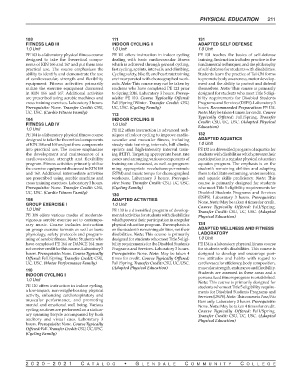Page 215 - GCC 2020-2021 Catalog
P. 215
PHYSICAL EDUCATION 211
103 111 131
FITNESS LAB III INDOOR CYCLING II ADAPTED SELF DEFENSE
1.0 Unit 1.0 Unit 1.0 Unit
PE 103 is a laboratory physical fitness course PE 111 offers instruction in indoor cycling PE 131 teaches the basics of self-defense
designed to take the theoretical compo- dealing with basic cardiovascular fitness training. Instruction includes practice in the
nents of KIN 166 and 167 and put them into which is achieved through general cycling, fundamental techniques, and the philosophy
practical use. The course emphasizes the fast cycling, sprints, intervals, and climbing. of self-defense for students with disabilities.
ability to identify and demonstrate the use Cycling safety, bike fit, and heart rate training Students learn the practice of Tai Chi forms
of cardiovascular, strength and flexibility are incorporated with choreographed work- to promote body awareness, motor develop-
equipment. Fitness activities primarily outs. Note: This course may not be taken by ment and the ability to protect and defend
utilize the exercise equipment discussed students who have completed PE 121 prior themselves. Note: This course is primarily
in KIN 166 and 167. Additional activities to Spring 2016. Laboratory 3 hours. Prereq- designed for students who meet Title 5 eligi-
are prescribed using aerobic machines and uisite: PE 110. Course Typically Offered: bility requirements for Disabled Students
cross training exercises. Laboratory 3 hours. Fall/Spring/Winter. Transfer Credit: CSU, Programs and Services (DSPS). Laboratory 3
Prerequisite: None. Transfer Credit: CSU, UC, USC. (Cycling Family) hours. Recommended Preparation: PE 134.
UC, USC. (Cardio Fitness Family) Note: May be taken 4 times for credit. Course
112 Typically Offered: Fall/Spring. Transfer
104 INDOOR CYCLING III Credit: CSU, UC, USC. (Adapted Physical
FITNESS LAB IV Education)
1.0 Unit
1.0 Unit 132
PE 112 offers instruction in advanced tech- ADAPTED AQUATICS
PE 104 is a laboratory physical fitness course niques of indoor cycling to improve cardio-
designed to take the theoretical components vascular and muscular fitness, including 1.0 Unit
of KIN 168 and 169 and put these components steady-state training, intervals, hill climbs,
into practical use. The course emphasizes sprints and high-intensity interval train- PE 132 is a diversified program of aquatics for
the development and maintenance of a ing (HIIT). Targeting appropriate heart rate students with disabilities which prevent their
cardiovascular, strength and flexibility zones and arranging various components of participation in a regular physical education
program. Fitness activities primarily utilize training are discussed, as well as program- aquatics program. The emphasis is on the
the exercise equipment discussed in KIN 168 ming appropriate revolutions-per-minute student’s remaining abilities and adapting
and 169. Additional intermediate activities (RPM) and music tempo for choreographed them to facilitate swimming, water aerobics,
are prescribed using aerobic machine and workouts. Laboratory 3 hours. Prerequi- and aquatic skills proficiency. Note: This
cross training exercises. Laboratory 3 hours. site: None. Transfer Credit: CSU, UC, USC. course is primarily designed for students
Prerequisite: None. Transfer Credit: CSU, (Cycling Family) who meet Title 5 eligibility requirements for
UC, USC. (Cardio Fitness Family) Disabled Students Programs and Services
130 (DSPS). Laboratory 3 hours. Prerequisite:
108 ADAPTED ACTIVITIES None. Note: May be taken 4 times for credit.
GROUP EXERCISE I Course Typically Offered: Fall/Spring.
1.0 Unit Transfer Credit: CSU, UC, USC. (Adapted
1.0 Unit Physical Education)
PE 130 is a diversified program of develop-
PE 108 offers various modes of moderate- mental activities for students with disabilities 134
vigorous aerobic exercise set to contempo- which prevent their participation in a regular ADAPTED WELLNESS AND FITNESS
rary music. Course includes instruction physical education program. The emphasis is LABORATORY
on group exercise formats as well as basic on the student’s remaining abilities, not their
physiology, safety protocols and program- disabilities. Note: This course is primarily 1.0 Unit
ming of aerobic fitness. Note: Students who designed for students who meet Title 5 eligi-
have completed PE 164 or DANCE 164 may bility requirements for the Disabled Students PE 134 is a laboratory physical fitness course
not receive credit for this course. Laboratory 3 Programs and Services. Laboratory 3 hours. for students with disabilities. This course is
hours. Prerequisite: None. Course Typically Prerequisite: None. Note: May be taken 4 designed to develop and encourage posi-
Offered: Fall/Spring. Transfer Credit: CSU, times for credit. Course Typically Offered: tive attitudes and habits with regard to
UC, USC. (Motor Performance Family) Fall/Spring. Transfer Credit: CSU, UC, USC. cardiovascular efficiency, body composition,
(Adapted Physical Education) muscular strength, endurance and flexibility.
110 Students are assessed in these areas and a
INDOOR CYCLING I personalized fitness program is established.
Note: This course is primarily designed for
1.0 Unit students who meet Title 5 eligibility require-
ments for Disabled Students Programs and
PE 110 offers instruction in indoor cycling, Services (DSPS). Note: This course is Pass/No
a low-impact, non-weight-bearing physical Pass only. Laboratory 3 hours. Prerequisite:
activity, enhancing cardiorespiratory and None. Note: May be taken 4 times for credit.
muscular performance, and promoting Course Typically Offered: Fall/Spring.
mental and emotional well being. Various Transfer Credit: CSU, UC, USC. (Adapted
cycling routines are performed on a station- Physical Education)
ary spinning bicycle accompanied by both
auditory and visual cues. Laboratory 3
hours. Prerequisite: None. Course Typically
Offered: Fall. Transfer Credit: CSU, UC, USC.
(Cycling Family)
2 0 2 0 – 2 0 2 1 C ATA L O G • G L E N DA L E C O M M U N I T Y C O L L E G E

